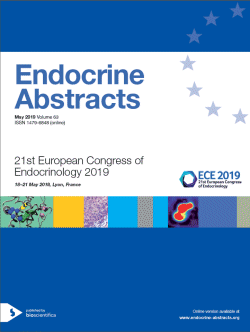Searchable abstracts of presentations at key conferences in endocrinology

21st European Congress of Endocrinology
Lyon,
France
18 May 2019 - 21 May 2019
18-21 May 2019, Lyon, France
ea0063nsa1 | (1) | ECE2019
Steroidomics
The central dogma of biology - a term coined by Francis Crick in 1957 - describes the flow of sequential information from genome via transcriptome, proteome and metabolome to the phenotype. Associated with each stage is the respective systems biology -omics tool, e.g. metabolomics. The metabolome represents the complete set of metabolites (low-molecular weight molecules) in a biological sample and metabolomics describes the systematic study of these sma...
ea0063nsa2 | (1) | ECE2019
Single cell spatial reconstruction of endocrine organs
Mammalian tissues are composed of heterogeneous populations of cells, interacting in highly structured microenvironments to achieve physiologic goals. Understanding the design principles of endocrine tissues organization requires approaches to analyze spatially-resolved sub-populations of cells within the tissue. The mammalian liver consists of hexagonal-shaped lobules, radially polarized by blood flow and morphogens. Key liver are differentially expressed along the lobule axi...
ea0063nsa3 | (1) | ECE2019
Intelligent image based in situ single cell isolation
Abstract Unavailable....
ea0063nsa4 | (1) | ECE2019
How can AI create value for the endocrinologist? Challenges and opportunities for AI-enabled solutions
The risk of unsustainability faced by many healthcare systems drives the focus on leveraging technology for effective solutions to key problems. Technologies such as AI, enabling to better leverage the power of data in healthcare, hold the potential to play a transformative role and contribute to improvements in both efficiency and quality. AI-enabled solutions may lead to lower costs, better patient outcomes, increased safety, streamlined information flows, and free healthcar...
ea0063nsa5 | (1) | ECE2019
Genome-wide effects of vitamin D on chromatin
Vitamin D3can be produced endogenously in UV-B exposed skin, but during winter months it should be supplemented via fortified foods or pills. The main physiological functions of vitamin D are the control of cellular metabolism and immunity via regulating calcium homeostasis and modulating the response of cells of the innate and adaptive immune system, respectively. The vitamin D metabolite 1α,25-dihydroxyvitamin D3 (1,25(OH)2D3)...
ea0063nsa6 | (1) | ECE2019
Diving into the brain: deep brain imaging techniques in conscious animals.
Survival of most species relies on the fact that small populations of endocrine neurons located in the hypothalamus determine critical functions such as reproduction, growth, and metabolism. These neurons are so finely regulated that their functions have been conserved across evolution; nonetheless, the mechanisms underlying these regulatory features remain hazy. Indeed, research efforts have been hindered by the complexity and inaccessibility of the hypothalamic-pituitary sys...



